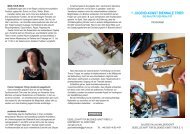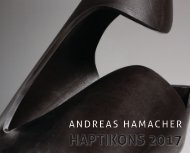Katalog_HAPTIKONS_Andreas-Hamacher_2016
Erfolgreiche ePaper selbst erstellen
Machen Sie aus Ihren PDF Publikationen ein blätterbares Flipbook mit unserer einzigartigen Google optimierten e-Paper Software.
<strong>Andreas</strong> <strong>Hamacher</strong><br />
<strong>HAPTIKONS</strong><br />
1
<strong>Andreas</strong> <strong>Hamacher</strong><br />
<strong>HAPTIKONS</strong><br />
I AM – Independent Art Museum Trier 17. Juni – 03. Juli <strong>2016</strong><br />
2 3
Inhalt<br />
7<br />
Anmerkungen zur Kunst von <strong>Andreas</strong> <strong>Hamacher</strong><br />
Gabriele Lohberg<br />
15 Haptikons<br />
57 transfer<br />
Brigitte Dittel<br />
58 Haptikon Nr. 14-2015<br />
62 Biografie<br />
64 Impressum<br />
4 5
Anmerkungen zur Kunst von <strong>Andreas</strong> <strong>Hamacher</strong><br />
Notes to the artists work of <strong>Andreas</strong> <strong>Hamacher</strong><br />
Es ist schon lange eine immer wieder gern zitierte Wahrheit, dass<br />
Kunst und Arbeit mehr miteinander zu tun haben, als der Betrachter<br />
und Rezipient sich denken mag. Gerade wenn ein Künstler mit<br />
physisch schweren Materialien umgeht wird deutlich, dass ohne<br />
physische Kraft und Energie eine Gestaltung des Ausgangsmaterials<br />
nicht möglich ist. Stahl ist ein besonders faszinierendes<br />
Material. Es zeichnet sich durch eine große Festigkeit und Zähigkeit<br />
aus – doch als Rohmaterial kann es unter Hitze gegossen, geschmiedet<br />
und in nahezu jede Form gebracht werden. Daher ist<br />
es in der Industrie oder beim Bauen vielseitig einsetzbar als massenhaft<br />
gefertigte Röhren, Platten und Gitter oder in Einzelanfertigungen<br />
zum Beispiel für spezielle Maschinen.<br />
Die physische und auch physikalische Arbeit, die der Bildhauer<br />
<strong>Andreas</strong> <strong>Hamacher</strong> leistet, ist beachtlich. Wie viel Kraft bedarf<br />
es, um Stahl bis zu 30 mm Stärke in die erdachte und gewünschte<br />
Form zu bringen? Wie viel Arbeit, um Stahl zu pressen, zu<br />
schneiden, auseinander zu ziehen, zu schleifen, zu erhitzen, zu<br />
bewegen! Auf diese Weise wird physikalisch messbare Energie z.<br />
B. durch Kompression, auf das Material übertragen. Die Eigenschaft<br />
des Formbaren und der kraftvolle Ausdruck des energetisch<br />
aufgeladenen Materials, begeistert Künstler des 20. und 21.<br />
Jahrhunderts immer wieder aufs Neue. Die sich verändernde, innere<br />
Energie lässt sich gemäß den Gesetzen der Thermodynamik<br />
sogar in eine Formel bringen, doch werden in den Werken von<br />
<strong>Andreas</strong> <strong>Hamacher</strong> diese kraftvollen Eigenschaften des Materials<br />
und des Herstellungsprozesses auch ohne sie sichtbar und vor<br />
allem spürbar. Der Künstler verwendet gern Stahl als Ausgangsmaterial,<br />
das ehemals für funktionale, meist industrielle Zusammenhänge<br />
gefertigt wurde. Diese vorgeformten Objekte findet er<br />
auf den Schrottplätzen von Trier und Luxemburg. Da dort jedes<br />
Teil nicht wegen seiner ursprünglichen Anwendung, sondern nur<br />
noch wegen seines Materialwerts lagert – um bald wieder eingeschmolzen<br />
und zu etwas anderem zu werden – verliert es seine<br />
It is a well-known and much quoted truism that art and labour<br />
have more to do with each other than the casual observer may first<br />
think. Particularly when an artist works with heavy-duty materials<br />
it becomes apparent they could not have been shaped without<br />
physical strength and vigour. Steel is an especially fascinating<br />
material. It is characterized by tremendous solidity and toughness,<br />
yet paradoxically in its molten state can be forged into<br />
almost any form conceivable. This versatility makes it popular<br />
in industry and the construction trade where it is used for<br />
mass produced tubes, sheets and grids or custom-built special<br />
machinery.<br />
The sheer bodily and elemental aspects of the work performed<br />
by the sculptor <strong>Andreas</strong> <strong>Hamacher</strong> are remarkable. Imagine how<br />
much strength it takes to shape steel up to 30 mm thick into the<br />
desired form. Or how much work it is to press, cut, pull apart,<br />
mill, heat, compress and move steel. Through these processes,<br />
physically measurable energy is transferred to the material.<br />
This malleability combined with the expressive dynamism of the<br />
energetically-laden material has inspired artists time and again<br />
during the 20th and 21st centuries. The shifting, inner energy<br />
can even be captured in a formula according to the laws of<br />
thermodynamics, but the powerful presence of the material and<br />
the creative process require no expression, being already visible in<br />
the works of <strong>Andreas</strong> <strong>Hamacher</strong> and above all tangible.<br />
The artist‘s material of choice is steel which was once manufactured<br />
for use in a functional, usually industrial, environment.<br />
He finds these pre-formed objects in the scrapyards of Trier and<br />
Luxembourg. Since every item stored there only still exists by dint of<br />
its purely material value, its primary purpose long forgotten. Soon<br />
it will be melted down again and become something new. Beyond<br />
any functional context, these items are the ideal starting point for<br />
the materialisation of his artistic visions.<br />
6 7
Zweckbestimmung. Außerhalb jeden Funktionszusammenhang<br />
ist es für <strong>Andreas</strong> <strong>Hamacher</strong> das willkommene Ausgangsmaterial,<br />
um künstlerische Ideen plastisch umzusetzen.<br />
Depending on the work phase, the artist prefers to use objects<br />
which are characterized to a greater or lesser degree by their<br />
history, their previous function. Once they have been found, the<br />
creative process which comes into play demands that numerous<br />
ter dem Begriff „vergegenständlichte Arbeit“ im weitesten Sinne<br />
alle Gebrauchswerte subsumiert. Indem der Mensch durch die<br />
Arbeit auf die Natur und die Umgebung außer ihm wirkt und sie<br />
verändert, verändert er zugleich seine eigne Natur. Nach Marx<br />
within and subjects the interaction between themselves and<br />
material to their own rules (see: Capital Band I; Fünftes Kapitel;<br />
Arbeitsprozess und Verwertungsprozess).<br />
Der Künstler bevorzugt je nach Werkphase Objekte, die – mal<br />
mehr mal weniger – von ihrer Geschichte, von ihrer ehemaligen<br />
Funktion, vom Gebrauch geprägt sind. Doch fordert der nach dem<br />
Finden einsetzenden kreativen Prozess zahlreiche Entscheidungen:<br />
Macht es Sinn, die Farbspuren in die Oberflächenbehandlung<br />
einzubeziehen? Wo werden die zum Teil sehr großen Elemente mit<br />
schweren Maschinen zerschnitten, gepresst? Wird die Oberfläche<br />
geschliffen – oder bleibt sie rau? Wie wird Innen und Außen sichtbar<br />
gemacht, wo treten haptische Reize auf – und wo bleibt das<br />
Werk mit einer Rostschicht überzogen? <strong>Andreas</strong> <strong>Hamacher</strong> sucht<br />
bewusst Metallobjekte aus, die Bezüge zu gegenständlichen oder<br />
figürlichen Formen erst gar nicht aufkommen lassen. Diese verarbeitet<br />
er dann in ähnlich gegenstandsunabhängiger Sichtweise<br />
weiter. Dabei lässt er sich vom Werkstück, vom Material inspirieren,<br />
doch sind die Arbeitsschritte zu vielfältig und mit so viel Aufwand,<br />
Kraft und Energie verbunden, dass ein planvolles Vorgehen<br />
unumgänglich ist, um die gewünschten Ergebnisse zu erreichen.<br />
decisions be made: does it make sense to integrate the traces of<br />
old paint in the surface treatment? Where should the heavy<br />
machinery cut and press the sometimes enormous elements?<br />
Should the surface be polished – or stay rough? How to make<br />
the inside and outside visible, what‘s the best place for haptic<br />
stimuli – and which areas should stay covered in a layer of rust?<br />
<strong>Andreas</strong> <strong>Hamacher</strong> consciously seeks out metal objects which<br />
don‘t allow any reference to concrete or figural forms to arise. He<br />
then processes them in a similar vein, outside the boundaries of<br />
objects. Whilst he allows himself to be inspired by the piece and<br />
the material it is made from, the individual work steps are so<br />
manifold and involve so much effort, strength and energy that a<br />
planned concept is essential in order to attain the desired results.<br />
A key role is adopted by the model in the position between the<br />
original conception and the transformation of the idea into steel.<br />
In <strong>Andreas</strong> <strong>Hamacher</strong>‘s works, the opposite of work and action<br />
also manifests itself: tranquillity, inspiration, leisureliness and<br />
entwickelt er die in ihm schlummernden Möglichkeiten und unterwirft<br />
das Wechselspiel zwischen sich und dem Material seinen<br />
eignen Regeln (sinngemäß in: Das Kapital Band I; Fünftes Kapitel;<br />
Arbeitsprozess und Verwertungsprozess). In Trier, der Geburtsstadt<br />
von Karl Marx, kommt man an dem Gedankengut des Philosophen,<br />
Ökonom, Gesellschaftstheoretiker und Protagonisten der<br />
Arbeiterbewegung in diesem Kontext nicht vorbei. Dem Künstler<br />
<strong>Andreas</strong> <strong>Hamacher</strong> gelingt es, aus dem Resultat einer ehemals<br />
fremdbestimmten Arbeit, ein Werk nach seinen Vorstellungen zu<br />
formen. In seinen Kunst-„Werken“ ist die ursprüngliche Verbindung<br />
von Kunst und „Arbeit“ auf verschiedenen Ebenen nachvollziehbar.<br />
Ein „Werk“ wie „Mittal Snack“ nimmt direkt Bezug auf die<br />
metallverarbeitende Industrie in Luxemburg – unweit von Trier,<br />
wo <strong>Andreas</strong> <strong>Hamacher</strong> lebt und arbeitet. Er verankert seine künstlerische<br />
Position in die Tradition der Schwerindustrie im Saarland,<br />
Luxemburg und Belgien. Er nutzt die Möglichkeiten, die sich für<br />
ihn als Künstler dadurch ergeben und gleichzeitig formt er die in-<br />
In Trier, birthplace of Karl Marx, there are constant reminders<br />
of the town‘s most famous son and the political theory of the<br />
philosopher, economist, social theorist and protagonist of the<br />
workers’ movement. In this context the artist <strong>Andreas</strong> <strong>Hamacher</strong><br />
succeeds in transforming objects which were once the result of<br />
work dictated by outside forces to an oeuvre in line with his own<br />
personal. In his art ’works‘, the original connection between<br />
art and ‚labour‘ can be comprehended at different levels. Some<br />
‚works‘, such as “Mittal” are a direct reference to the metalworking<br />
industry in Luxembourg – not far from Trier, where <strong>Andreas</strong><br />
<strong>Hamacher</strong> lives and works. His artistic stance is anchored in the<br />
tradition of heavy industry of the Saarland, Luxembourg and<br />
Belgium. He utilizes the opportunities this environment provides<br />
him with as an artist while simultaneously channelling the<br />
industrial aspect into a creative, individual and self-determined<br />
position.<br />
So nimmt die Beschäftigung mit dem Modell eine Schlüsselposition<br />
ein zwischen der Idee und ihrer Vorstellung und Umsetzung in<br />
Stahl. Im Werk von <strong>Andreas</strong> <strong>Hamacher</strong> wird neben der Arbeit, der<br />
Tätigkeit auch ihr Gegenteil sichtbar: Ruhe, Inspiration, Muße, das<br />
Ergreifen einer überraschenden Chance, ein stimmiger Moment,<br />
kurz das, was als kreativer Prozess bezeichnet wird. In diesem Sinne<br />
beschreibt Platon „Arbeit“ sowohl als eine physisch-handwerkliche<br />
Tätigkeit, als „bewusste schöpferische Auseinandersetzung<br />
mit der Natur und der Gesellschaft“, als auch als die geistig-kontemplative<br />
Muße als Grundbedingung für schöpferische Arbeit.<br />
the capture of a serendipitous happening a harmonious moment,<br />
in short, what is known as the creative process. It is in this sense<br />
that Plato describes ”work” as being both a physical, mechanical<br />
activity and “conscious, creative interaction with nature and<br />
society”, as well as the intellectual-contemplative serenity required<br />
as a prerequisite for creative work.<br />
In ‚Capital‘, Karl Marx describes human activity in running production<br />
process as “living labour”, while he subsumed the term<br />
“objectified labour” in its widest sense to mean all use value.<br />
dustrielle Arbeit in eine kreative, individuelle selbstbestimmte Position<br />
um.<br />
Als Bildhauer beschäftigt er sich intensiv mit Grundfragen des<br />
Volumens, des Aufbrechens, der Durchblicke, Vielansichtigkeit,<br />
der Oberfläche und Bewegung im Raum. Seit Henry Moore und<br />
Hans Arp sind die „Leerformen“, die Löcher und Öffnungen in<br />
einer skulpturalen Form von Bedeutung: „Sie brechen die Geschlossenheit<br />
des Gebildes auf und verleihen ihm ein gewisses<br />
Maß an Transparenz. Sie wirken als Blickfang und lenken die<br />
As a sculptor, he is deeply absorbed with fundamental questions<br />
concerning volume, dehisces, vistas, multi-perspectivity, surfaces<br />
and movement in space. Since Henry Moore and Hans Arp,<br />
‚empty spaces‘, the holes and openings in a sculptural form, have<br />
acquired significance. “They break up the cohesion of the entity<br />
and bestow upon it a certain measure of transparency. They act<br />
as an eye-stopper, diverting attention away from the surface<br />
into the interior of the object.” (Rudolf Suter, Hans Arp: ‚Weltbild<br />
und Kunstauffassung im Spätwerk‘, Bern 2007, S. 420).<br />
Karl Marx bezeichnet im „Kapital“ die Tätigkeit des Menschen in<br />
laufenden Arbeitsprozessen als„lebendige Arbeit“, während er un-<br />
Through work, humans influence the natural world and the<br />
external surroundings, while at the same time changing their own<br />
nature. According to Marx humans develop the potential dormant<br />
Aufmerksamkeit von der Oberfläche ab auf das Innere der Plastik“<br />
(Rudolf Suter, Hans Arp Weltbild und Kunstauffassung im<br />
Spätwerk, Bern 2007, S. 420). Beim Umschreiten der Werke von<br />
As you move around one of <strong>Andreas</strong> <strong>Hamacher</strong>‘s sculptures, new<br />
vistas constantly open up. But the inner cavities formed inside the<br />
tubes are not visible from every angle. The vantage point from<br />
8 9
<strong>Andreas</strong> <strong>Hamacher</strong> entstehen tatsächlich ständig neue, sich verändernde<br />
Ansichten. Doch ist nicht von allen Seiten das Hohlvolumen<br />
zu sehen, das sich im Innern der Röhren bildet. Der<br />
Standpunkt, von dem die Öffnung zu erkennen ist, ist auch derjenige,<br />
in der die optimale Offenlegung des Formgeschehens mit<br />
der maximalen Transparenz zusammenfallen. Die Lösungen, die<br />
der Künstler für die anspruchsvollen Perspektivwechsel findet,<br />
sind beeindruckend und überzeugend.<br />
Der Behandlung der Oberflächen widmet <strong>Andreas</strong> <strong>Hamacher</strong> sich<br />
in ebensolcher Intensität: „Auf der Suche nach Formen, Texturen<br />
und Flächen entstehen Arbeiten, die den Betrachter animieren<br />
anzufassen und zu begreifen. Dabei ist mir das Spannungsfeld<br />
zwischen dem schroff Abweisenden und dem scheinbar weich<br />
Einladenden des Materials wichtig“. Dies trifft vor allem auf die<br />
Werkreihe der „Haptikons“ zu, die er 2013 entwickelte. Diese<br />
Skulpturen überzeugen durch ihre körperhaften Proportionen<br />
und fließende Formen, die sich besonders bei der Berührung intensiv<br />
und angenehm vermitteln. Dieser Eindruck wird von der<br />
Oberfläche unterstützt, die zwischen glänzend poliert und eingeschriebenen<br />
Gebrauchsspuren, changiert. Dabei steigern sich die<br />
elegant geschliffenen Stellen und die rauen Partien gegenseitig<br />
in der Wirkung.<br />
Beim Blick auf die Geschichte der Kunst wird deutlich, dass<br />
Pablo Picasso und Julio Gonzáles als eine der ersten Künstler des<br />
20. Jahrhunderts Materialen vom Schrottplatz für Skulpturen<br />
verwendeten. Sie haben aus Gebrauchsgegenständen, sogenannte<br />
„objets trouvés“ zusammengesetzt, um ihnen dann durch<br />
den Bronzeguss eine einheitliche Form zu geben. Bernhard Luginbühl<br />
und Jean Tinguely verwendeten um 1960 industriell gefertigte,<br />
ausrangierte Metallteile wie Stahlträger, Räder etc., und<br />
schweißten sie zu Kunstwerken zusammen. Diese Arbeiten wurden<br />
als kreativer Umgang mit dem Industriematerial und als zeit-<br />
which you can detect an opening is also the exact spot where<br />
the optimum unravelling of the form coincides with maximum<br />
transparency. The solutions which the artist finds for sophisticated<br />
changes in perspective are both striking and impressive.<br />
Surfaces are also treated with the same intensity. <strong>Andreas</strong><br />
<strong>Hamacher</strong>: “While searching for forms, textures and planes, works<br />
arise which encourage the observer to feel and comprehend via the<br />
sense of touch. The field of tension which arises between the harsh<br />
aloofness and the apparently soft, inviting aspect of the material<br />
is important to me.” This is true above all of the “Haptikons” series<br />
which <strong>Hamacher</strong> created in 2013. These powerful pieces with their<br />
satisfying physical-like proportions and flowing forms, can best<br />
be experienced by touching them. This impression is reinforced by<br />
the surfaces, which alternate between slick and shiny and those<br />
imprinted with vestiges of previous usage. Polished elegance and<br />
roughness mutually enhance their impact.<br />
A look at the history of art shows that Pablo Picasso and Julio<br />
Gonzáles were among the first artists of the 20th century to use<br />
materials from scrapyards for their sculptures, juxtaposing castoff<br />
everyday items, so-called ‚objets trouvés’, which were<br />
then cast in bronze to give them a unified form. Around 1960,<br />
Bernhard Luginbühl and Jean Tinguely were welding industriallymade,<br />
discarded metal pieces such as steel girders, wheels and<br />
so on to create works. This ingenious use of industrial materials<br />
was regarded as a contemporary, artistic interpretation of the<br />
machine age.<br />
To conclude it can be said that the recognition factor plays no<br />
role for <strong>Andreas</strong> <strong>Hamacher</strong>, on the contrary. Being able to identify<br />
what the newly discovered objects were previously used for would<br />
only distract from the form. It is this that the artist really cares<br />
about. His sculptures were not only energetically charged during<br />
10 11
gemäßer, künstlerischer Ausdruck des Maschinenzeitalters interpretiert.<br />
Zusammenfassend kann gesagt werden, dass für <strong>Andreas</strong><br />
<strong>Hamacher</strong> der Wiedererkennungseffekt, also wofür die gefundenen<br />
Objekte früher eingesetzt wurden, nicht wichtig ist. Im Gegenteil.<br />
Eine erkennbare Funktion würde von der Form, auf die es dem<br />
Künstler ankommt, nur ablenken. Die Skulpturen wurden durch die<br />
Bearbeitung nicht nur energetisch aufgeladen, sondern bekommen<br />
so ein Eigenleben. Sie sind weniger Produkte „vergegenständlichter“<br />
Arbeit, sondern haben sich durch die kreative Umformung und<br />
Bearbeitung mit der Person des Künstlers verbunden. Sie sind zu<br />
unverwechselbaren Kunstwerken geworden, die auch durch ihren<br />
Ursprung und Verankerung in der metallverarbeitenden Großregion<br />
eine besondere Glaubwürdigkeit erhalten. Schwere Skulpturen<br />
aus Metall herzustellen hat selbstverständlich auch mit<br />
handwerklicher und maschineller Arbeit zu tun. Doch wenn das<br />
Schweißen, Schleifen, Polieren, Schneiden so gut beherrscht und<br />
eingesetzt wird, nimmt der Betrachter dieses Können als quasi<br />
selbstverständlich kaum wahr. Er kann sich auf die Entwicklung<br />
der Skulptur im Raum und die haptischen Qualitäten der Oberflächen<br />
konzentrieren. Der Entwicklung der Formen im Raum wird<br />
eine Freiheit und Souveränität verliehen, die sich auch als autonome<br />
Stärke vermittelt. Die Werke von <strong>Andreas</strong> <strong>Hamacher</strong> vermitteln<br />
eine Vielzahl von Eindrucken und Informationen, doch zeichnet sich<br />
jede Skulptur durch einen eigenen Charakter, eine eigene Aussage<br />
aus. Es bedarf nicht unbedingt großer Formate, um die Aufmerksamkeit<br />
des Betrachters zu erwecken. Vielmehr ist es die starke<br />
Präsenz im Raum, die die Skulpturen von <strong>Andreas</strong> <strong>Hamacher</strong> unübersehbar<br />
machen. Die energetische Ausstrahlung vermittelt sich<br />
dem Betrachter unmittelbar; sie fordert und schärft seine Wahrnehmung<br />
und verleitet zum haptischen Erleben zum Anfassen.<br />
their creation, they were also given a life of their own. They are<br />
not so much the products of “objectified” labour, rather they<br />
have fused with the artist himself through a creative process of<br />
formation and transformation. They have become distinctive<br />
works of art, imbued with a special authenticity having originated<br />
in and still being anchored in the metalworking tradition of<br />
the wider region. Creating heavy sculptures out of metal also<br />
inevitably involves elements of manual and machine labour. But<br />
when welding, grinding, polishing and cutting are so skilfully<br />
mastered and staged, these invisible skills are taken for granted.<br />
The observer is able to concentrate on the impact of the sculpture<br />
in space and on the haptic qualities of the surfaces. The forms<br />
have also been given the freedom to evolve in space with effortless<br />
ease and an aura of sovereignty which at the same time conveys<br />
autonomous strength.<br />
It is common to all works of <strong>Andreas</strong> <strong>Hamacher</strong> that they<br />
communicate multiple impressions and messages, but each piece<br />
also has its own unique character and statement to make. It isn‘t<br />
necessarily large-scale format which gain the observer‘s attention.<br />
It is the unmistakable presence of <strong>Andreas</strong> <strong>Hamacher</strong>‘s sculptures,<br />
independent of scale, which make them so outstanding. The energy<br />
they radiate announces their existence to the beholder with a<br />
directness which demands their attention, sharpening their sense<br />
of perception and enticing them to partake of a haptic experience,<br />
to touch.<br />
Dr. Gabriele Lohberg<br />
Dr. Gabriele Lohberg<br />
12 13
<strong>HAPTIKONS</strong><br />
14 15
Haptikon Nr. 15-2013<br />
16 17
18 Haptikon Nr. 15-2013, 17 x 12 x 32 cm, Steeltube<br />
19
Haptikon Nr. 10-2014<br />
20 21
22 Haptikon Nr. 10-2014, 60 x 60 x 20 cm, Steeltube<br />
23
Haptikon Nr. 06-2013<br />
24 25
26 Haptikon Nr. 06-2013, 64 x 53 x 25 cm, Steeltube<br />
27
Haptikon Nr. 02-2015<br />
28 Haptikon Nr. 02-2015, 23 x 14 x 23 cm, Steeltube<br />
29
Mosel Nr. 14-2014<br />
30 31
32 mosel Nr. 14-2014, 120 x 140 x 130 cm, Steeltubes<br />
33
Haptikon Nr. 12-2015<br />
34 35
36 Haptikon Nr. 12-2015, 30 x 20 x 20 cm, Steeltube, temper colored brown<br />
37
Haptikon Nr. 05-2015<br />
38 39
40 Haptikon Nr. 05-2015, 38 x 29 x 22 cm, Steeltube, temper colored blue<br />
41
Haptikon Nr. 11-2015<br />
42 43
44 Haptikon Nr. 11-2015, 90 x 50 x 40 cm, Steeltube<br />
45
Haptikon Nr. 08-2015<br />
46 47
48 Haptikon Nr. 08-2015, 34 x 35 x 22 cm, Steeltube, temper colored gold<br />
49
Haptikon Nr. 09-2015<br />
50 51
52 Haptikon Nr. 09-2015, 60 x 93 x 95 cm, Steeltube<br />
53
Haptikon Nr. 13-2015<br />
54 55
transfer<br />
dem leben verloren<br />
stehen sie<br />
am ufer scheinbar<br />
geduldig ihr blick<br />
zielt in dunkles hinüber<br />
die münder sind leer<br />
und jenseits des flusses<br />
bellt dreimal ein hund<br />
der fährmann bleibt reglos<br />
sein kahn liegt zerbrochen<br />
Brigitte Dittel<br />
56 Haptikon Nr. 13-2015, 109 x 85 x 75 cm, Steeltube<br />
57
Haptikon Nr. 14-2015<br />
58 59
60 Haptikon Nr. 14-2015, 70 x 56 x 48 cm, Steeltube<br />
61
Biografie<br />
<strong>Andreas</strong> <strong>Hamacher</strong><br />
Stahlskulpteur<br />
* 1967 Lebt und arbeitet in Trier<br />
<strong>2016</strong> Preisträger „I AM Kunstpreis <strong>2016</strong>“<br />
2015 Internationales Skulpturen Symposium „Mosel KM 193“<br />
seit 2014 internationale Ausstellungsreihe „ruß ’n’ rost“<br />
in Kooperation mit Bettina Reichert<br />
1994 –2013 Studium an der Europäischen Kunstakademie Trier<br />
Schwerpunkt „Metall-Skulptur“ bei Jörg Oetgen, Christoph Lahl<br />
und Mathias Lanfer<br />
Regelmäßige Ausstellungstätigkeit in Deutschland,<br />
der Schweiz und Luxembourg<br />
www.andreas-hamacher.eu<br />
62 63
Impressum<br />
Diese Publikation erscheint anlässlich der Ausstellung<br />
<strong>Andreas</strong> <strong>Hamacher</strong>. <strong>HAPTIKONS</strong><br />
vom 17.06. – 03.07.<strong>2016</strong><br />
im Independent Art Museum Trier<br />
I AM (Independend Art Museum) Kunstpreis <strong>2016</strong><br />
Text<br />
Dr. Gabriele Lohberg, Trier<br />
Konzeption, Fotografie<br />
<strong>Andreas</strong> <strong>Hamacher</strong>, Trier<br />
<strong>Katalog</strong>gestaltung, Lithografie<br />
www.kataloglabor.jimdo.com<br />
Herausgeber & Gesamtherstellung<br />
Druckerei + Verlag Fölbach<br />
Schützenstraße 44, 56068 Koblenz<br />
© <strong>2016</strong> <strong>Andreas</strong> <strong>Hamacher</strong> und Autorin<br />
ISBN 978-3-95638-037-2<br />
64 65
66









